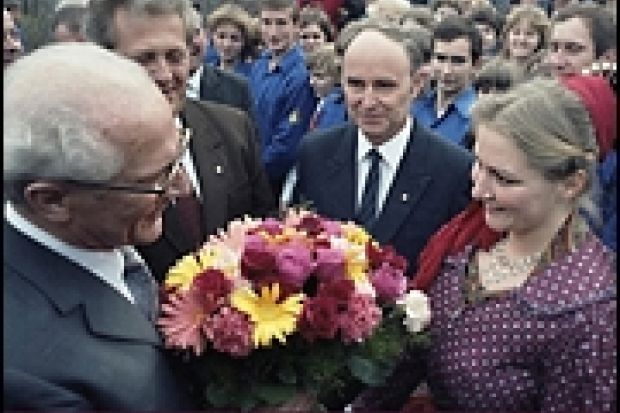Visitors to the German Democratic Republic were often struck by the starkness of the dichotomy between tradition and modernity in its cultural self-representation. The hero of one (fairly typical) children's book was a mechanical digger that merrily ripped up forests, bulldozing spaces for sprawling cityscapes. Yet on adjacent shelves one could leaf through magazines full of soft-focus photographs of bucolic vistas and folksy kitsch. The contrast may be characteristic of "catch-up" industrialising countries in general, but was strikingly so of the GDR.
The burden of Jan Palmowski's argument is that the elevation of heimat (homeland/local heritage) in the GDR should be understood with reference to the problems faced by its ruling Communist Party (SED) in exercising power and constructing a nation within a non-national state. Given its racial and volkisch connotations, heimat culture could not readily be linked to Communism, and in the early years of "socialist construction" it was downplayed. One Communist despaired that he had to deal with popular tastes that during Hitler's dictatorship had been "drenched in the syrup of light entertainment and operetta". Yet functionaries could not but recognise its endemic popularity, with talks on "Heimat, our joy" or the "Mysteriousness of the Alps" attracting large audiences.
Gradually, the SED set about making heimat culture its own. Its leftist lineages were traced, for example to the 1920s workers' rambling movement, and folklore was hailed as "a source of power for our people in its fight for the victory of socialism". Heimat was also alloyed to an argument that represented the GDR as the authentic Germany, nemesis to the cosmopolitan, Americanised West Germany with its "pseudo-culture, criminality, horror, drug addiction and pornography". In music, SED officials argued, it was better to broadcast kitschy heimat Lieder than songs that thrummed to the "sounds of the jungle".
Heimat, Palmowski shows, was recruited to the purpose of naturalising the new regime, anchoring it in a mythical, primeval German past. By the late 1960s, the GDR's self-representation was less dominated by socialist or humanist cultural motifs and increasingly by homeland and nation. Heimat was added to the school curriculum, and Prussian history revalued. Folklore festivals and exhibitions were held, under banners such as "Our Life is Rich and Beautiful" and "Our Beautiful German Heimat". Well-groomed properties received a "Golden House Number", while settlements that were models of "orderliness, cleanliness and discipline" were awarded "The Beautiful Village" (or, in urban areas, "The Beautiful Residential District") prize. Although Palmowski chooses to accept the regime's "socialist" self-definition, to me this penchant for "orderliness" and "love for the GDR fatherland" rather evokes conservatism.
Did its turn to heimat assist the SED in promulgating nationalism? The record, argues Palmowski, was mixed. Heimat did provide an "imagery of rootedness and primordiality that was indispensable if citizens were to develop a love of their country". It bolstered some key functions of nationalism: to harmonise tradition and transition, and to mythically unite a class-divided society. But heimat also represented a compromise. The SED recognised that the population could not be poured into its ideological mould, and that it would have to adapt its cultural aspirations, and definition of nationhood, to existing popular practices. The preservation of authentic folklore implicit in the heimat ideal, moreover, sat uneasily beside futuristic ideals of socioeconomic transformation. Attempts to combine the two principles, as for example the "Festival of the Fully Collectivized Village", were complete failures.
Borrowing a concept from James C. Scott, Palmowski suggests that heimat operated as a regime-propagated "public transcript" to which individuals were expected to subscribe, but that this did not require outright obeisance to the SED agenda. Individuals created wiggle room in which to develop their alternative transcripts. They played the system, overtly subscribing to the public transcript of "socialist heimat" while pursuing private agendas, accompanied by "hidden transcripts" that departed from the ruling ideology. Recognising this, SED functionaries lamented that heimat events were primarily excuses for "excessive eating and drinking", with mere lip service paid to "socialism".
At times, Palmowski overstates the centrality of heimat, and he permits it a surfeit of meanings: "local tradition", "nation", "recreation", "heritage". The book would also have benefited from greater awareness of wider literatures. The analysis of nationalism, for example, refers to barely any theorists, while Palmowski's claim to be a pioneer in applying Scott's concepts to East Germany is reckless.
Yet his book does illuminate a hitherto neglected field, convincingly documenting the SED's attempt to inculcate national consciousness and charting the adroit stratagems by which individuals were able to cultivate their desires while placating the functionaries who demanded deference to the official mantra: "GDR, our beautiful socialist heimat".
Inventing a Socialist Nation: Heimat and the Politics of Everyday Life in the GDR, 1945-1990
By Jan Palmowski
Cambridge University Press
360pp, £60.00
ISBN 9780521111775
Published 5 November 2009
Register to continue
Why register?
- Registration is free and only takes a moment
- Once registered, you can read 3 articles a month
- Sign up for our newsletter
Subscribe
Or subscribe for unlimited access to:
- Unlimited access to news, views, insights & reviews
- Digital editions
- Digital access to THE’s university and college rankings analysis
Already registered or a current subscriber? Login
